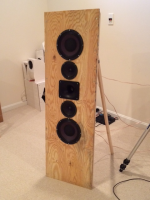hi XRK971 - that H07E looks like a great match for a pair of PA130
It's a WG16-25 elliptical 45x45 deg waveguide. It is wider horizontally so not sure why vertical and horizontal coverage is the same.
Here is their catalog. PRV makes nice stuff - priced well and great build quality and performance. The WG sounds very smooth with initial testing out of the baffle.
http://www.prvaudio.mx/pdf/2014_PRVAudio_Catalog.pdf
I just noticed that they make a 2in dia CD (108dB) with Nd motor that goes down to 500Hz for $200. That is quite the value. That might be a more ideal HF driver for a B&O hole filler as it has wider bandwidth and let's you sit a a lower XO frequency. D3220Ti-ND
http://www.parts-express.com/prv-au...orn-compression-driver-8-ohm-4-bolt--294-2851
Last edited:
WMTMW B&O
Here is my gen 2 using an WMTMW layout to get better integration and more efficiency. Woofers are Beta 8cx, mids are PA130-8, tweeter is PRV D280Ti with 45x45 WG16-25B waveguide.
Still optimizing XO and delays so work in progress. Very loud... but dual 8's in an OB don't cut it for bass. I will enlarge cutouts and swap for 12's.
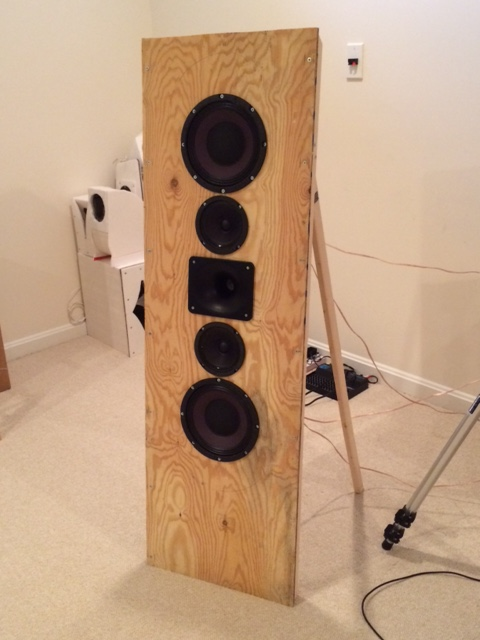
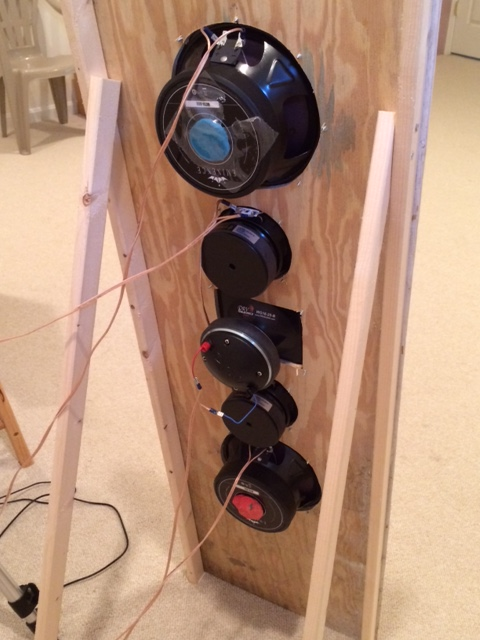
Here is my gen 2 using an WMTMW layout to get better integration and more efficiency. Woofers are Beta 8cx, mids are PA130-8, tweeter is PRV D280Ti with 45x45 WG16-25B waveguide.
Still optimizing XO and delays so work in progress. Very loud... but dual 8's in an OB don't cut it for bass. I will enlarge cutouts and swap for 12's.


Attachments
Are you going to stain the baffle, use shellac or veneer?
Can't wait to see some results, should be fun! 🙂
Can't wait to see some results, should be fun! 🙂
It sounds like a filler driver is used to reduce the effects of phase shift anomolies at the crossover frequency in a system that has a crossover point in the band where the ear is most sensitive (800 - 6kHZ). This phase shift varies as you transition through the crossover frequency, causing the beam of maximum acoustic output to shift, the effect of which will be brought more to life by the acoustics of the room. If the drivers are stacked vertically, the beam will move vertically, creating an inconsistency in the crossover frequency region of how the speaker interacts with the listening room acoustics.
The filler driver may need to have a pretty wide bandwidth, but the tweeter may also need to be able to go low enough without coil tilt IM distortion becoming an issue too. If the crossover has low order rolloff rates, this could be an issue.
Personally, I design for there to be no crossover point between about 800HZ and 6kHZ (using the Peerless TG9 or Vifa TC9 driver for midrange), and I'm very happy with the results. I actually biamp 4th order at 500HZ, and do a passive one pole at 8kHZ.
The filler driver may need to have a pretty wide bandwidth, but the tweeter may also need to be able to go low enough without coil tilt IM distortion becoming an issue too. If the crossover has low order rolloff rates, this could be an issue.
Personally, I design for there to be no crossover point between about 800HZ and 6kHZ (using the Peerless TG9 or Vifa TC9 driver for midrange), and I'm very happy with the results. I actually biamp 4th order at 500HZ, and do a passive one pole at 8kHZ.
Great have best progress and fun.
Notice this is the third time in 2015 baffle is made of wood 😛
Notice this is the third time in 2015 baffle is made of wood 😛
Great have best progress and fun.
Notice this is the third time in 2015 baffle is made of wood 😛
When you have 25lbs of drivers to support foam core doesn't cut it🙂
It sounds like a filler driver is used to reduce the effects of phase shift anomolies at the crossover frequency in a system that has a crossover point in the band where the ear is most sensitive (800 - 6kHZ). This phase shift varies as you transition through the crossover frequency, causing the beam of maximum acoustic output to shift, the effect of which will be brought more to life by the acoustics of the room. If the drivers are stacked vertically, the beam will move vertically, creating an inconsistency in the crossover frequency region of how the speaker interacts with the listening room acoustics.
The filler driver may need to have a pretty wide bandwidth, but the tweeter may also need to be able to go low enough without coil tilt IM distortion becoming an issue too. If the crossover has low order rolloff rates, this could be an issue.
Personally, I design for there to be no crossover point between about 800HZ and 6kHZ (using the Peerless TG9 or Vifa TC9 driver for midrange), and I'm very happy with the results. I actually biamp 4th order at 500HZ, and do a passive one pole at 8kHZ.
That is why a full range is used for the filler driver so it can be xo with first order slope. You have a point about phase shift but it sounds pretty good to me and I haven't noticed the vertical beam shifting.
The tweeter will be 2nd order LR at 2400Hz, one octave above recommended minimum XO. The woofer XO is also LR2 but at 600Hz. The mid fills in the hole created by both LR2 woofer and mids canceling steeply at 1200Hz.
Are you going to stain the baffle, use shellac or veneer?
Can't wait to see some results, should be fun! 🙂
This is research lab speaker test bed so no I won't be painting it. If I make a permanent speaker then yes.
.....Personally, I design for there to be no crossover point between about 800HZ and 6kHZ (using the Peerless TG9 or Vifa TC9 driver for midrange), and I'm very happy with the results. I actually biamp 4th order at 500HZ, and do a passive one pole at 8kHZ.
Sorry if you already noticed but x did this same thread a TG9FD 8ohm version.
Pictures here http://www.diyaudio.com/forums/multi-way/88135-filler-driver-ala-b-o-3.html#post4378443 and measurements including nice step response and square waves here http://www.diyaudio.com/forums/multi-way/88135-filler-driver-ala-b-o-20.html#post4387563.
B&O with Beta 12cx, 5MR450NDY, D280Ti
I swapped out the woofers for the Beta 12cx to get some real bass, while I was at it, I decided to swap the mids to the higher sensitivity 5MR450NDY. Both the woofers and mids are now wired in parallel (4 ohms nominal) in order to boost sensitivity by 6dB for same voltage.
Here is what it looks like:
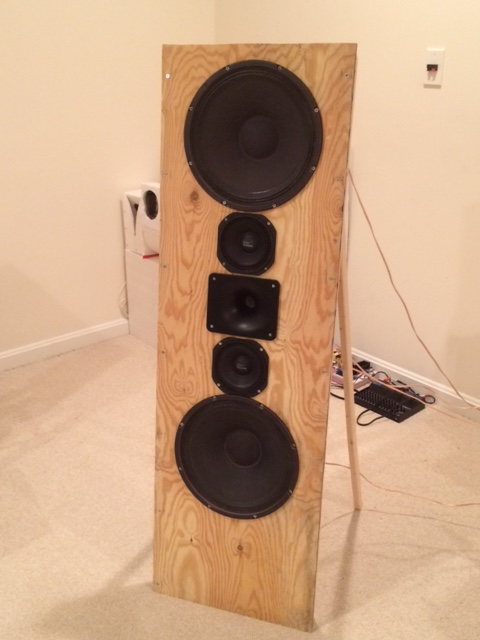
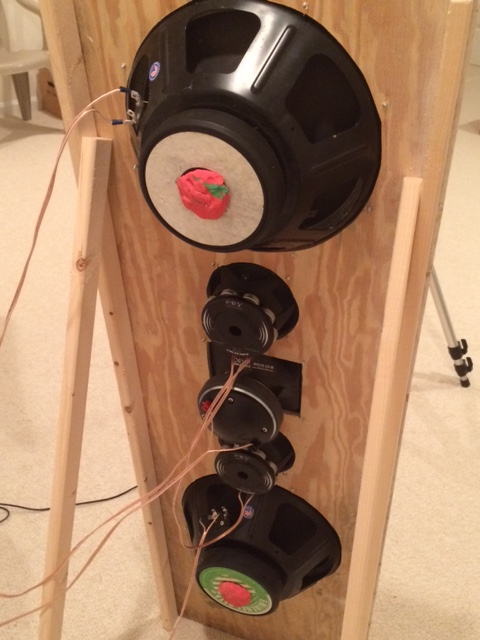
And after some initial quick and dirty DSP settings adjusted (delays and very minor EQ) we get this for acoustical crossover. I am using the mid in a wide mode in order to keep the mid in the telephone band without a XO.
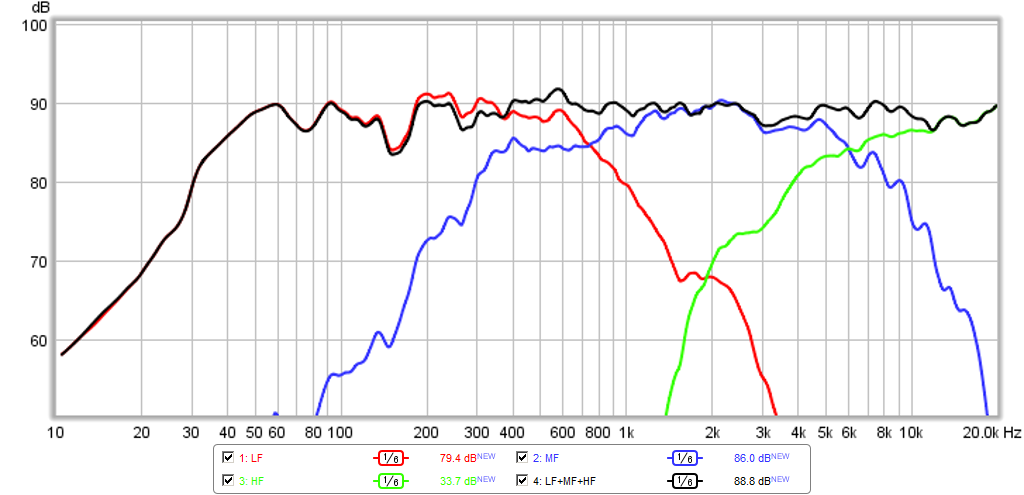
Here is the XO setting in miniDSP:

Here is the impulse response:
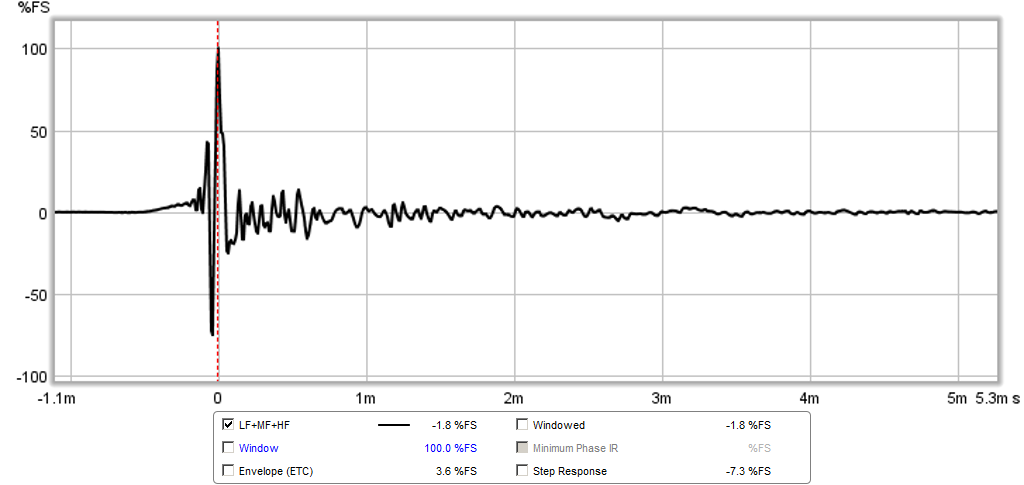
Here is the step response:

Still listening to it now, so far so good.
I swapped out the woofers for the Beta 12cx to get some real bass, while I was at it, I decided to swap the mids to the higher sensitivity 5MR450NDY. Both the woofers and mids are now wired in parallel (4 ohms nominal) in order to boost sensitivity by 6dB for same voltage.
Here is what it looks like:


And after some initial quick and dirty DSP settings adjusted (delays and very minor EQ) we get this for acoustical crossover. I am using the mid in a wide mode in order to keep the mid in the telephone band without a XO.

Here is the XO setting in miniDSP:

Here is the impulse response:

Here is the step response:

Still listening to it now, so far so good.
Attachments
-
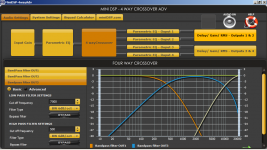 beta12cx-5mr450ndy-d280ti-xo-minidsp.png105.3 KB · Views: 752
beta12cx-5mr450ndy-d280ti-xo-minidsp.png105.3 KB · Views: 752 -
 beta12cx-5mr450ndy-d280ti-sr.png39.5 KB · Views: 743
beta12cx-5mr450ndy-d280ti-sr.png39.5 KB · Views: 743 -
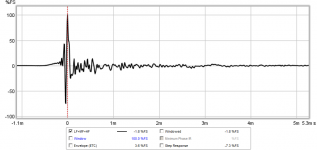 beta12cx-5mr450ndy-d280ti-ir.png45 KB · Views: 755
beta12cx-5mr450ndy-d280ti-ir.png45 KB · Views: 755 -
 beta12cx-5mr450ndy-d280ti-xo.png83.6 KB · Views: 1,099
beta12cx-5mr450ndy-d280ti-xo.png83.6 KB · Views: 1,099 -
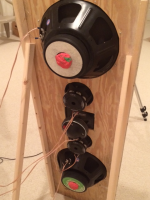 gen2-beta12cx-5mr450ndy-d280ti-back-photo.png564.4 KB · Views: 767
gen2-beta12cx-5mr450ndy-d280ti-back-photo.png564.4 KB · Views: 767 -
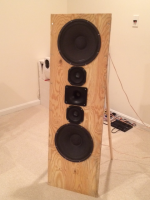 gen2-beta12cx-5mr450ndy-d280ti-front-photo.png434.6 KB · Views: 25,359
gen2-beta12cx-5mr450ndy-d280ti-front-photo.png434.6 KB · Views: 25,359
that looks strong - how does it sound to you so far? what is the impression of the higher sensitivity mids vs PA130?
Last edited:
Pretty good starting point xrk971. Have you tried hammering the drivers into close to perfect slopes using the miniDSP EQ?
It sounds much cleaner than the PA130-8 which has a lot more breakup peaks in the 5k area. The system is indeed "strong". After building it and looking at how intimidating it looks I realize it is a bonafide pro audio blaster. Two 95dB sensitive woofers, two 95dB sensitive mids, and a CD and horn capable of 108dB. On paper it should be about 101dB at 2.83v and 4ohm system.
I got to listen to only several tracks so far and recorded them too but have not had chance to post yet. The sound is very good - balanced overall as can be seen from frequency response. As expected it sounds good with all genres. The TG9FD-DC28F-TG9FD combo seems to have slightly better articulation of the upper registers - but that was because the system had more of the HF's handled by the soft dome. But this system has a lot of reserves left over as the drivers are able to still take on a lot more power. Acoustic guitar realism and attack is still sure convincingly realistic. Eric Clapton's "Unplugged" is rendered very well.
The system is very loud as one would expect.
I got to listen to only several tracks so far and recorded them too but have not had chance to post yet. The sound is very good - balanced overall as can be seen from frequency response. As expected it sounds good with all genres. The TG9FD-DC28F-TG9FD combo seems to have slightly better articulation of the upper registers - but that was because the system had more of the HF's handled by the soft dome. But this system has a lot of reserves left over as the drivers are able to still take on a lot more power. Acoustic guitar realism and attack is still sure convincingly realistic. Eric Clapton's "Unplugged" is rendered very well.
The system is very loud as one would expect.
Pretty good starting point xrk971. Have you tried hammering the drivers into close to perfect slopes using the miniDSP EQ?
No, I tried this last time with the other drivers and found that it requires too much PEQ that it sounded phasey yet did not make the SR any better. I find that this sounds best with minimal EQ and let the acoustical slope take whatever it ends up as. Just need to make it electrically LR2-BW1-LR2.
That is why a full range is used for the filler driver so it can be xo with first order slope. You have a point about phase shift but it sounds pretty good to me and I haven't noticed the vertical beam shifting.
The tweeter will be 2nd order LR at 2400Hz, one octave above recommended minimum XO. The woofer XO is also LR2 but at 600Hz. The mid fills in the hole created by both LR2 woofer and mids canceling steeply at 1200Hz.
Since our ears are spaced horizontally, I don't think we would necessarily sense a beam moving vertically. I think such an anomoly would cause an inconsistency in the sense of ambiance in the listing room, which could mess with the sense of speakers disappearing. Especially in smaller rooms. Given the acoustic effects of most rooms, I don't know how audible anything to do with phase really is. As long as the two channels have the same phase, and it doesn't cause a suckout at a crossover point.
If my guess as to how a filler driver works is wrong, I encourage others to correct me and share their beliefs. 😎
Bob,
Is the problem you are referring to noticeable in a Dunlavy monitor which uses the same WMTMW setup? How would I measure this effect? Vertical polars ? But sounds like what you are talking about is a transient effect.
Is the problem you are referring to noticeable in a Dunlavy monitor which uses the same WMTMW setup? How would I measure this effect? Vertical polars ? But sounds like what you are talking about is a transient effect.
No, I'm talking about a single midrange driver and tweeter with an analog crossover that has no time alignment (although it could). the phase shift from the crossover (and possibly from the drivers themselves as well), will cause the variable beaming as a sine wave is swept through the crossover region.
Hi X,
Nice setup. It looks strong.
How far does it need to be well integrated? It's quite tall.
Can you identify which channel is causing the pre-ringing?
Nice setup. It looks strong.
How far does it need to be well integrated? It's quite tall.
Can you identify which channel is causing the pre-ringing?
CLS,
I believe it is too Strong for my little listening room 🙂 it integrates well even at 1m away. The CTC distance from mids to tweeter is not too big. The big woofers are low passed at about 500Hz. The pre ring is probably the tweeter CD diffraction off the hard edge that is not flush. Still trying to debug that. If you notice Dunlavy surrounded his tweeter with little strips of open cell foam.
I believe it is too Strong for my little listening room 🙂 it integrates well even at 1m away. The CTC distance from mids to tweeter is not too big. The big woofers are low passed at about 500Hz. The pre ring is probably the tweeter CD diffraction off the hard edge that is not flush. Still trying to debug that. If you notice Dunlavy surrounded his tweeter with little strips of open cell foam.
- Status
- Not open for further replies.
- Home
- Loudspeakers
- Multi-Way
- "Filler" driver ala B&O
